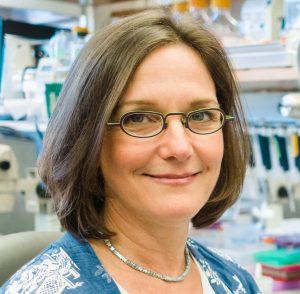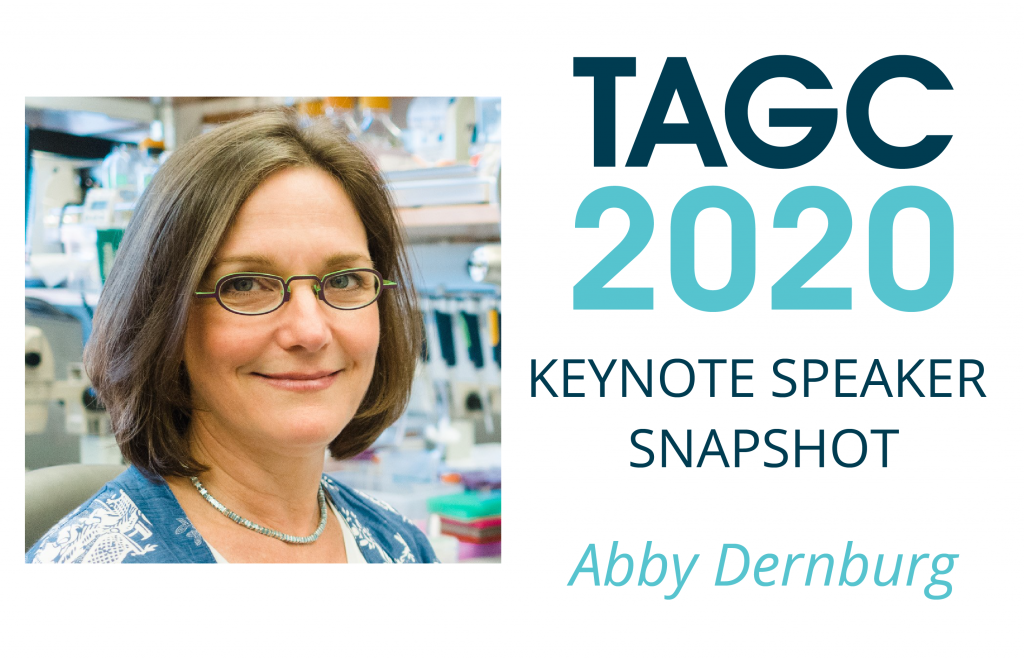Get to know the TAGC 2020 Keynote Speakers through our interview series.

Abby Dernburg
Abby Dernburg investigates how genetic information is transmitted from parents to progeny through the specialized cell division of meiosis. She received the Larry Sandler Memorial Award (from GSA’s Annual Drosophila Research Conference) for her graduate work with John Sedat at UCSF, where she explored diverse questions in chromosome biology. Her postdoctoral work with GSA Medal recipient Anne Villeneuve helped to establish C. elegans as a leading model organism for molecular genetic analysis of meiosis. Since 2001 she has led a research group at Lawrence Berkeley National Laboratory and UC Berkeley, where she was also an undergraduate. She has been an HHMI Investigator since 2008.
What research are you most excited about right now, and why?
There’s a question I’ve always wanted to answer that we’re finally making progress toward, which is the very long-standing mystery of how chromosomes recognize each other during meiosis. We had to wait until we had both the technology and the conceptual framework to enable us to address the question. I think those are both there now, finally letting us attack the question head on. So much is still unknown, but that makes it fun for me because I don’t know what we’ll find.
What do you like about working with C. elegans?
I see myself more as a chromosome person than someone who works with a particular organism. That’s one reason I’m very excited about TAGC: the opportunity to interact with lots of different model organism people. There’s a lot of synergy between what you can do in different systems. We mostly work with C. elegans, but we’re also developing a secondary model by developing tools to study recombination and meiosis in P. pacificus, which shows surprising differences in what we think of as core aspects of this process. By comparing these different nematodes, we see how plastic these mechanisms are by how they are modified during evolution. It helps to avert an absolutist mindset.
Is there anything about yourself or the field that made you feel like you didn’t belong in science? What would you say to early career scientists struggling with the same feeling?
I didn’t know if I was going to go on in academia—or if I even had the potential—until very late in grad school. I worry that students today feel pressure to sort it out too early. I was relatively comfortable with the ambiguity, which I realize was a kind of privilege. Obviously, I did decide to go on, but not with great conviction or certainty. It just never became the wrong path. I sometimes feel funny when I’m asked for career advice. In a way, you become an academic by not making choices, so I haven’t really experienced other potential futures.
TAGC aims to foster collaboration between communities and disciplines. Can you give an example of a collaboration that really helped your work?
When I started grad school, I wanted to become a crystallographer. I left that path early on when I fell in love with microscopy and chromosomes. But my most exciting collaboration in recent years has been with a crystallographer: Kevin Corbett, who I knew when he was a PhD student at Berkeley. He became a structural biologist with a focus on meiosis, which is what we work on, so it was a nice convergence of interests that led us to collaborate. It’s been a very productive collaboration, and I hope to do more of this in the future.
One thing that’s really changed in genetic research and model organism studies is the ability to do genome editing. We can now do much more detailed structure/function studies in model organisms than we have been able to do in the past, and having structural information about the proteins we work on enables us to develop specific hypotheses and test them in vivo. That’s a lot of fun.
Select Publications from the Dernburg Lab
A compartmentalized signaling network mediates crossover control in meiosis
Zhang L, Köhler S, Rillo-Bohn R, Dernburg AF
Elife. 2018 Mar 9;7. pii: e30789. doi: 10.7554/eLife.30789
Superresolution microscopy reveals the three-dimensional organization of meiotic chromosome axes in intact Caenorhabditis elegans tissue
Köhler S, Wojcik M, Xu K, Dernburg AF
Proc Natl Acad Sci U S A. 2017 Jun 13;114(24):E4734-E4743. doi: 10.1073/pnas.1702312114
The synaptonemal complex has liquid crystalline properties and spatially regulates meiotic recombination factors
Rog O, Köhler S, Dernburg AF
Elife. 2017 Jan 3;6. pii: e21455. doi: 10.7554/eLife.21455
The auxin-inducible degradation (AID) system enables versatile conditional protein depletion in C. elegans
Zhang L, Ward JD, Cheng Z, Dernburg AF
Development. 2015 Dec 15;142(24):4374-84. doi: 10.1242/dev.129635
The Chromosome Axis Mediates Feedback Control of CHK-2 to Ensure Crossover Formation in C. elegans
Kim Y, Kostow N, Dernburg AF
Dev Cell. 2015 Oct 26;35(2):247-61. doi: 10.1016/j.devcel.2015.09.021













